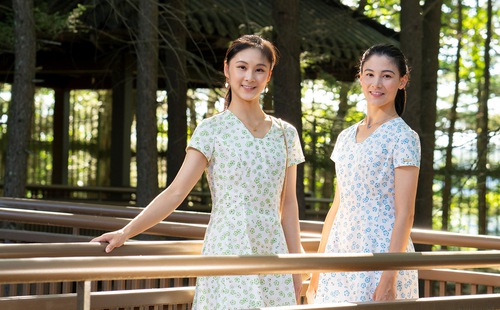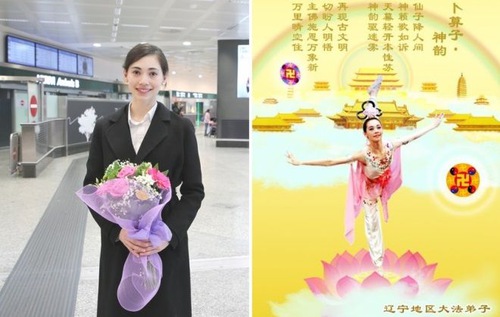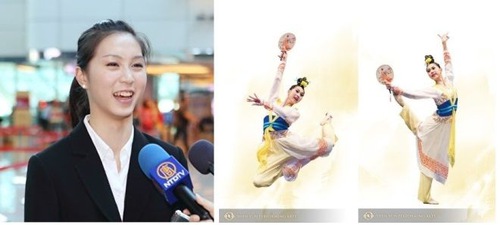(Minghui.org) After watching Shen Yun, I was deeply inspired by the ethereal sense of elegance, grace, and nobility behind the movements of the female dancers. They truly captured the gentility, virtue, beauty, and wisdom of the traditional Chinese woman, and it wasn’t something that was just on the surface—it was a natural, easy elegance that exuded from the heart and soul of each performer.
 Shen Yun dancers are an embodiment of elegance. (shenyundancer.com)
Shen Yun dancers are an embodiment of elegance. (shenyundancer.com)
After the Chinese Communist Party (CCP) took control of China in 1949, it began systematically destroying the culture and morality that has grounded the Chinese people for the past five millennia.
This effort crested during the Cultural Revolution from 1966 to 1976, where the traditional norms of life were completely uprooted and replaced with the CCP culture of class struggle. Chinese people were effectively torn from our own cultural bloodline, becoming orphans without a sense of ancestral belonging or defining values.
As a result, the image of the junzi, or “modest gentleman,” who valued justice over personal gain, was virtually erased from Chinese society. We grow more distant from the stories of those who valued integrity and honor over their lives with each passing day. And the fine qualities of the classical Chinese woman have become distorted beyond recognition.
In its quest for violent revolution and perpetual class struggle, the CCP deliberately downplayed the differences between men and women. It rejected the values of traditional femininity, decrying them as “suppressive proclivities from feudal society.” Instead, the Party wanted “iron women” who “did whatever the Party told them to.”
Decades later, China today is filled with “modern women,” who are aggressive, gaudy, and domineering. On top of that, many have their egos inflated from being financially independent, which makes it nearly impossible to find the virtues of their foremothers in their bearing.
According to the theory of yin and yang—a cornerstone of traditional Chinese culture—men are of yang nature. This means that their inclination is to be strong and tough. Women, on the other hand, are of yin nature, meaning that their predisposition is to be gentle and soft. This balance between yin and yang, flexibility and strength, grace and power, is what enables men and women to live together in harmony. Each supports the other with complementary strengths.
However, in China today, many women have upset this balance, micromanaging their men and leaving them no room to breathe. These men are timid and afraid, without any say in the affairs of the family, while the women aim to control every aspect of their men from their finances to their mental state. The warmth and rapport that characterize a healthy family life are nowhere to be found, leading to the proliferation of high divorce rates and extramarital affairs.
 The balance of opposites between traditional men and women ensures a fruitful family life. (Pixabay)
The balance of opposites between traditional men and women ensures a fruitful family life. (Pixabay)
When problems occur, people often look for surface level causes without digging deeper for the root. In this case, the root cause is the corruption of people’s morality as they deviate further and further away from the moral norms that have sustained humanity for thousands of years.
In fact, I also see this distorted mentality in myself. On the one hand, I want my husband to be stronger than me, and lionhearted like a real man. At the same time, I always try to outdo him and demand that he listens to me. It’s no wonder that my husband is always at a loss, not knowing what to do to make me happy. Driven by a an unhealthy mentality like this, how could any woman sustain a happy family?
I have benefited a lot from watching Shen Yun, and I have also taken a lot of inspiration from Shen Yun’s performers as to how we can revive and manifest the virtues of quintessential Chinese women in our world today.
Here are a few of their experiences.
A Dance Style Shaped By a Magnificent Cultural Legacy
Cao Xiang, a dance teacher at Feitian Academy of the Arts and a former Shen Yun principal dancer, says that classical Chinese dance has a distinctive style and personality. It is extremely vivid in its expressions and possesses unique requirements for a performer’s inner bearing. Most importantly, it is an expression of China’s grand cultural legacy, enriched by a language of connotations and allusions gathered from the experiences of Chinese people throughout history.
The bearing aspect of classical Chinese dance sets it apart from most other dance forms. A performer's bearing, or yun, adds an additional layer of feeling to each movement, and originates from the values that Chinese people have espoused for millennia: purity, honesty, compassion, and beauty.
“The study of classical Chinese dance includes the training of a person’s spirit, energy, and mind. So when studying classical Chinese dance, a person’s character and behavior will actually change for the better as he masters the dance techniques—a bit at a time, even without the person himself knowing it,” said Cao. “For example, it can make a shy, nervous child cheerful and optimistic. A mischievous, flighty child becomes steady and strong.”
“In Shen Yun performances, the male dancers are vigorous and dynamic, full of energy, and give off a brilliant vitality. The female dancers exhibit the modesty, grace, and nobleness that define the quintessential woman.”
 Left: Principal dancer Miranda Zhou-Galati. Right: A homemade New Year greeting card by a Falun Gong practitioner in China with a photo of Zhou-Galati.
Left: Principal dancer Miranda Zhou-Galati. Right: A homemade New Year greeting card by a Falun Gong practitioner in China with a photo of Zhou-Galati.
Miranda Zhou-Galati is another principal dancer with Shen Yun, who has studied the traditional Chinese woman extensively in order to portray her onstage.
“A humble attitude is very important,” said Zhou-Galati. “As we learn classical Chinese dance, we are also learning many things from traditional Chinese history and culture. Those things, in turn, are reflected in the way we dance, just like how a piece of poetry is a representation of the poet’s inner being.”
Her experience in perfecting her portrayal of Hua Mulan onstage illustrates how Shen Yun dancers cultivate their craft—and themselves.
“As a girl who joined the army in her father’s place, Mulan should be much stronger and braver than other girls her age,” said Zhou-Galati.
She spent a lot of time in the library, reading books and historical texts that documented the story of Hua Mulan. With this understanding in mind, she would practice countless movements in front of the studio mirror, trying to find the right gestures that could faithfully depict the heroine.
Zhou-Galati’s investigation took her deep into the character’s psyche, where she found two different facets to Hua Mulan’s identity. The first was the warrior, dauntless and determined, who had the fortitude to lead a battalion from the front lines. The second was the daughter, the persona she returned to after doffing her armor for the very last time. This side of Hua Mulan was gentle, graceful, and devoted to her father and family.
“To express yun in my dance, I would read a lot of books about Chinese culture. Because the physical movements of authentic classical Chinese dance are often built upon a piece of history or culture that carries very rich connotations,” said Zhou-Galati. “When I play a role in a dance theater piece, I would look up her story first and find out what makes her so special, what her personality is like, and when faced with the situations she encounters, what kinds of complex emotions and thoughts are going through her head?”
Through the combination of character study and dance training, Zhou-Galati has continuously deepened her understanding of Chinese culture. During this process, she has come to see the profound significance of her impact as a Shen Yun dancer.
 “Nüwa Mending the Sky” performed by Miranda Zhou-Galati, who won the gold medal in the adult women’s group of the 6th International Classical Chinese Dance Competition.
“Nüwa Mending the Sky” performed by Miranda Zhou-Galati, who won the gold medal in the adult women’s group of the 6th International Classical Chinese Dance Competition.
“The ancient Chinese people paid great attention to morality, which is also the most important component of classical Chinese dance and other traditional Chinese art forms,” she said.
“After I truly grasp the inner qualities of the character I play, I’d start trying out different dance moves to get a feel for the shades of meaning conveyed by each movement and see which ones could best portray the virtues of the character,” she continued. “This way, the characters I play can genuinely touch the hearts of the audience and help them appreciate the beauty and value of traditional Chinese culture.”
A Dance Style That Originates from the Heart
Over 20 years ago, a little girl from Taiwan had a dream. In her dream, she flew into the sky and saw a group of xian’nü, or celestial maidens, dancing among the clouds. They were clothed in a pale yellow gossamer, and their exquisite movements exuded a radiant, warm energy.
Seeing this scene, the little girl couldn’t help her excitement.
“I want to dance with them!” she yelled.
In 2008, this girl, named Tiffany Lin, arrived in New York from Nantou, Taiwan, to begin her training as a Shen Yun dancer. As she went further in her training, she found that some of the dances she learned were exactly the same as what she saw in her dream all those years ago.
 Tiffany Lin, gold medalist in both the 5th and 6th NTDTV International Classical Chinese Dance Competition.
Tiffany Lin, gold medalist in both the 5th and 6th NTDTV International Classical Chinese Dance Competition.
Since childhood, Lin has received an education steeped in tradition Chinese culture, which helped her appreciate and convey the soul of classical Chinese dance in her performance.
“Classical Chinese dance requires the dancer to dance from the heart. It is a dance form where the movement starts from the core of your being and extends outward. You lead your movement with your heart, and then your body follows,” she said. “So when a dancer performs with his or her heart, the performance is powerfully emotive and contagious. It can break down the barriers between nations and cultures, so that people around the world can understand the stories and inner meanings that our dances convey.”
“Xian’nü embodies the angelic beauty of divine beings, while the yangko showcases the folksy charm of high spirits. As long as you’re able to find the beauty within each subject and express it through your dance, the audience will feel it and resonate with it,” said Lin.
The performances by Lin and all the Shen Yun artists are not only unparalleled in technique, but also extremely intricate in how they depict emotions and inner thoughts. This is a difference that audiences can feel, with many audience members even saying things like, “they are dancing with their whole lives,” and “their dancing is alive!”
 Tiffany Lin in a dance competition.
Tiffany Lin in a dance competition.
Lin believes that the reason many audience members find Shen Yun dances so moving has to do with the inherent nature of classical Chinese dance.
“The defining characteristic of classical Chinese dance is that it comes from the heart. You have to start every movement from your heart, which is then connected to every layer of life, of existence. On top of that, our performance carries a divinely-inspired message, which requires us to use an even purer heart and a compassionate spirit when we dance. I believe this is why the audience feels that we are dancing with our lives,” she said.
“Art originated from the divine, and humanity’s earliest works of art all evinced a divine connection. The purpose of art is to convey the grandeur and magnanimity of gods so that people can be inspired towards kindness. So I believe that the closer an art form is to the divine, the more elevated it is.”
All content published on this website is copyrighted by Minghui.org. Minghui will produce compilations of its online content regularly and on special occasions.
Category: News Commentary








